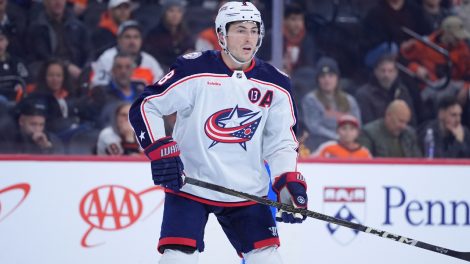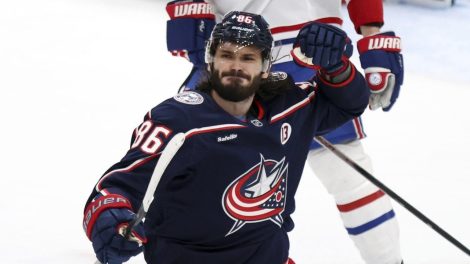There are four types of Era Adjusted articles:
• The “Best of All-Time” arguments
• Compare This Guy vs. That Guy
• Contrast This Guy vs. That Guy
• Holy crap, look at this!
This is the fourth type. Specifically, let’s take an Era Adjusted look at Mario Lemieux’s 2000-01 comeback from retirement.
As the NHL’s Dead Puck Era started to kick into overdrive in 1997, Lemieux decided to retire at just 32-years-old. Three years later, now as an owner, Lemieux decided to make his comeback at 35.
This Saturday, Hockey Night in Canada is airing a feature ‘For Austin’ that details Lemieux’s decision to come out of retirement and how he kept his plans under wraps.
Personally, this is extra fascinating because it’s something I’m old enough to remember, but wasn’t old enough to appreciate at the time. Even looking at the numbers today, they seem fake. Are they real? They can’t be.
Lemieux’s first game of the 2000-01 season was against the Toronto Maple Leafs. One goal and two assists for three points.
Lemieux’s second game was against the Ottawa Senators. One goal and three assists for four points.
Here’s a look at Lemieux’s first eight games in his comeback, via nhl.com:

Lemieux scored in each of his first four games; scored at least two points in each of his first six games, and scored at least one point in each of his first eight games.
After Lemieux’s point-scoring streak was snapped in game nine against Anaheim, he began a nine-game point-scoring streak. In his first 18 games back after missing three years, Lemieux racked up 35 points. Go ahead and read that again if you need to. I know I did.
Jeez, what else?
How about this: Lemieux failed to register a point in just six of the 43 games he played that season. For reference, Lemieux scored three or more points in 11 out of those 43 games, or more than a quarter of the time.
In his abbreviated comeback season of 2000-01:
• Lemieux led the NHL in goals-per-game (0.81) while Pavel Bure, the league’s leading goal-scorer that season (59), was second (0.72).
• Lemieux led the NHL in assists-per-game (0.95) while Adam Oates and his own teammate Jaromir Jagr tied for second (0.85).
• Lemieux led the NHL in points-per-game (1.77) while Jagr finished second (1.49).
Nobody was even close.
Had Lemieux played in all 82 games that season, he would have been on pace for 144 points. The person who ended up winning the scoring race that season was Jagr, who finished with 121 points. Joe Sakic finished second to Jagr with 118 points, while no one else hit the 100-point plateau.
Now: Era Adjusted.
Many months ago, I tried to write about Lemieux vs. Sidney Crosby for my first stab at one of these Era Adjusted articles. I had honestly hoped that it would be a little closer. After all, Crosby is one of those players who people bring up the old “time machine scenario” whereby if you let him play back in the 1980s or something he would have dominated.
Crosby’s numbers are incredible. And Lemieux absolutely crushes him.
Lemieux scored 76 points in the 43 games he played in 2000-01. Since scoring was down that season — and for all of the late 1990s — adjusting for era boosts Super Mario’s point total up to 82. Again, that’s in 43 stinking games!
Remember when I said Lemieux was on pace to score 144 points in 82 games? Adjusting for era boosts that number up to 156 points.
Again, this is a 35-year-old who missed three years of hockey, had two back surgeries, and went through radiation treatment for Hodgkin’s disease.
Speaking of which, let’s take a brief look at Lemieux’s 1993 comeback from the aforementioned radiation treatment.
During the first 40 games of the 1992-93 NHL season, Lemieux had an incredible 110 points (39 goals, 71 assists). Coming off of back-to-back Stanley Cup wins, Lemieux and the Pittsburgh Penguins were riding high.
Then came the terrible news that Lemieux, who was the best player in the world at the time, had been diagnosed with Hodgkin’s disease.
Two months later Lemieux came back after completing his radiation therapy. And he might have been even better.
Lemieux put up an astonishing 56 points in the 20 games that followed his comeback, 30 of which were goals. He failed to register a point just twice in those 20 games while scoring five goals in a game once and four goals in a game twice.
Lemieux’s pre-diagnosis pace was 2.6 points per game. After he came back: 2.85.
Here are the full-season averages for 1992-93 via hockey-reference.com:

How. On. Earth.
I can’t tell you how many times I had to re-count these numbers to make sure they were right. How was anybody ever that good at anything? Lemieux was that good post-radiation late in the season and early in the season when he was playing with yet-to-be-diagnosed cancer.
But back to 2000-01.
The out-of-retirement comeback story wasn’t all sunshine and rainbows. He only played 24 games the following season, followed by 67 games in 2002-03, 10 games in 2003-04, and 26 games in 2005-06. That blasted full-season lockout, man. Lemieux finished with 690 career goals. Could he have cracked 700? Probably, even if he had played only a couple dozen games, if that. We’ll never know though.
In the 170 games Lemieux played following his comeback from retirement, he had 229 points. For reference, in Phil Kessel’s 194 games with the Penguins he “only” has 164 points. Same amount of Cups, though.
What happens when you adjust the 229 points Lemieux scored in those 170 games for era? His numbers are boosted to 250 era adjusted points. That’s 120 era adjusted points per season had he stayed healthy.
Honestly, just go to Mario Lemieux’s HockeyReference page. It’s pretty much your duty as a hockey fan at this point. You can thank me when you’re done in a couple hours.










